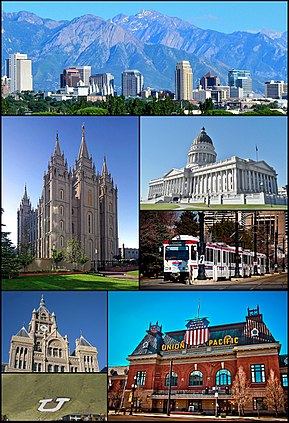What Is Business Law and How Does It Affect Your Business?
Business law in Utah is a body of law that governs the formation, operation, and dissolution of businesses in the state of Utah. This legal field encompasses a wide range of topics, including contract law, corporate law, and labor law. Utah business law also covers a variety of other areas, such as business licensing and taxation. This article will explore the history of business law in Utah, the various types of law related to business in Utah, and the impact of business law on businesses located in the state.
History of Business Law in Utah
Business law in Utah has evolved over time, as the state has adapted to changing economic conditions and technological developments. Initially, the state’s legal framework was largely based on the English common law system. This system was adopted by the state’s original settlers, who were largely of English origin. Over time, the state developed its own set of business laws that incorporated elements of the English common law system.
Utah’s business laws were further developed in the late 19th century, when the state experienced a period of industrial growth. This period saw the passage of various laws that sought to provide protection for businesses, such as the formation of limited liability companies and the adoption of the Uniform Commercial Code (UCC). These laws remained largely unchanged until the mid-20th century, when the state began to recognize the importance of technology in the business world and began to pass laws that addressed the various issues that technology can create.
Types of Business Law in Utah
Business law in Utah covers a wide range of topics, including contract law, corporate law, labor law, and business licensing and finally business taxation. Bankruptcy law, Federal law and other laws can play a role for your business as well. For example, if you have a construction business, you’ll need a contractor’s license or if you’re a dentist, you’ll need a dental license, etc.
Contract Law
Contract law in Utah is governed by the state’s version of the UCC, which was adopted in 1973. This law governs the formation, performance, and termination of contracts between individuals and businesses. It also sets out the remedies that may be available in the event of a breach of contract. Contract law is an important part of the legal system in the state of Utah. It provides the framework for the enforcement of agreements between parties. This article has explored the various aspects of contract law in Utah, as well as the requirements for the formation and enforcement of contracts in the state. Additionally, this article has discussed the remedies available to parties in the event of a breach of contract.
Corporate Law
Corporate law in Utah is largely based on the state’s version of the Model Business Corporation Act (MBCA). This is codified as Utah Code 16-10a. This law governs the formation, operation, and dissolution of corporations in the state. It sets out the rights and obligations of corporate shareholders, directors, and officers, as well as the procedures for issuing shares and holding shareholder meetings.
Utah corporate laws are among some of the most well established in the nation. Companies that are established in Utah must adhere to the rules and regulations set forth by the state. These laws govern all aspects of running a business, from the capital structure to the fiduciary responsibilities of directors and shareholders. The Utah Business Corporation Act governs the formation and operation of corporations in the state, and outlines the rules for issuing shares and preferred stock, paying dividends, and winding up the company if necessary.
Under Utah corporate laws, a liquidator is appointed when a company is winding up and is responsible for settling the company’s debts and distributing assets. In the event of compulsory liquidation, the court appoints a liquidator who is responsible for overseeing the process. The liquidator also has the power to sue for the recovery of assets, and to bring legal action against anyone who has been found to be in breach of the company’s fiduciary duties.
Under Utah corporate laws, directors and shareholders are obligated to disclose any material non-public information, such as insider trading, they may have. Any breach of these obligations can result in a lawsuit. Furthermore, the capital structure of the company must adhere to the rules outlined in the Utah Business Corporation Act. This includes the payment of preferred dividends and the issuance of preference shares.
Utah corporate laws are studied extensively in law school, and the Law School Admission Test (LSAT) includes a section devoted to corporate law. Many Utah law schools have professors who specialize in corporate law, and those wishing to practice corporate law in Utah must have a thorough understanding of the state’s laws.
Labor Law
Labor law in Utah is governed by the state’s labor code, which sets out the rights and responsibilities of employers and employees. It is codified as Utah Code 34A-1-101 et seq. It also establishes minimum wage and overtime pay requirements, as well as workplace safety standards.
Business Licensing and Taxation
Businesses operating in Utah must obtain a business license from the state. The state also imposes various taxes on businesses, such as income tax, sales tax, and property tax.
Impact of Business Law in Utah on Businesses
Every business in Utah is affected by business laws. Business law in Utah has a significant impact on businesses operating in the state. The various laws related to business in Utah provide legal protection for businesses and ensure that they are able to operate in a safe and fair environment. The laws also provide guidance on how businesses should conduct themselves and help to ensure that businesses comply with all applicable laws and regulations.
Business law in Utah is governed by both state and federal laws. The state of Utah has its own laws and regulations that need to be followed by businesses operating in the state. Federal laws are also enforced in Utah, such as the Sherman Act and the Clayton Act, which are antitrust statutes that prohibit monopolies, price-fixing, and other trade practices that are considered anti-competitive.
The Fair Labor Standards Act (FLSA) is a federal law that sets standards for overtime pay, minimum wage, and other labor related issues. Businesses in Utah must adhere to the provisions of the FLSA, as well as the state of Utah’s own labor and employment laws.
The Federal Trade Commission (FTC) is responsible for enforcing antitrust statutes in the state of Utah. The FTC is charged with investigating and punishing companies that engage in colluding and other anti-competitive practices. The FTC also enforces the law against deceptive and misleading advertising.
Businesses in the Mountain West and Southwest regions of the United States and all along with Wasatch Front must be aware of the laws and regulations governing tip pools and tip sharing, as well as the requirements for registering an agent for service of process.
Any businesses operating in the state of Utah need to be aware of the federal and state laws governing their operations, including those related to antitrust, labor and employment, advertising, and registration of an agent for service of process. Failing to comply with these laws can result in heavy fines and other penalties.
Consultation With A Utah Business Lawyer
Business law in Utah is an important area of law that governs the formation, operation, and dissolution of businesses in the state. The various types of business law in Utah, such as contract law, corporate law, labor law, and business licensing and taxation, all play an important role in ensuring that businesses in the state are able to operate in a legal and fair environment. Business law in Utah also has a significant impact on businesses by providing them with legal protection and guidance on how to properly conduct their operations.
Utah Business Lawyer Free Consultation
When you need a Utah business attorney, call Jeremy D. Eveland, MBA, JD (801) 613-1472.
Jeremy Eveland
17 North State Street
Lindon UT 84042
(801) 613-1472
Areas We Serve
We serve businesses and business owners for succession planning in the following locations:
Business Succession Lawyer Salt Lake City Utah
Business Succession Lawyer West Jordan Utah
Business Succession Lawyer St. George Utah
Business Succession Lawyer West Valley City Utah
Business Succession Lawyer Provo Utah
Business Succession Lawyer Sandy Utah
Business Succession Lawyer Orem Utah
Salt Lake City
|
Salt Lake City, Utah
|
|
|---|---|
| City of Salt Lake City[1] | |

Clockwise from top: The skyline in July 2011, Utah State Capitol, TRAX, Union Pacific Depot, the Block U, the City-County Building, and the Salt Lake Temple
|
|
| Nickname:
“The Crossroads of the West”
|
|

Interactive map of Salt Lake City
|
|
| Coordinates: 40°45′39″N 111°53′28″WCoordinates: 40°45′39″N 111°53′28″W | |
| Country | |
| State | Utah |
| County | Salt Lake |
| Platted | 1857[2] |
| Named for | Great Salt Lake |
| Government
|
|
| • Type | Strong Mayor–council |
| • Mayor | Erin Mendenhall (D) |
| Area | |
| • City | 110.81 sq mi (286.99 km2) |
| • Land | 110.34 sq mi (285.77 km2) |
| • Water | 0.47 sq mi (1.22 km2) |
| Elevation
|
4,327 ft (1,288 m) |
| Population | |
| • City | 200,133 |
| • Rank | 122nd in the United States 1st in Utah |
| • Density | 1,797.52/sq mi (701.84/km2) |
| • Urban
|
1,021,243 (US: 42nd) |
| • Metro
|
1,257,936 (US: 47th) |
| • CSA
|
2,606,548 (US: 22nd) |
| Demonym | Salt Laker[5] |
| Time zone | UTC−7 (Mountain) |
| • Summer (DST) | UTC−6 |
| ZIP Codes | |
| Area codes | 801, 385 |
| FIPS code | 49-67000[7] |
| GNIS feature ID | 1454997[8] |
| Major airport | Salt Lake City International Airport |
| Website | Salt Lake City Government |
Salt Lake City (often shortened to Salt Lake and abbreviated as SLC) is the capital and most populous city of Utah, as well as the seat of Salt Lake County, the most populous county in Utah. With a population of 200,133 in 2020,[10] the city is the core of the Salt Lake City metropolitan area, which had a population of 1,257,936 at the 2020 census. Salt Lake City is further situated within a larger metropolis known as the Salt Lake City–Ogden–Provo Combined Statistical Area, a corridor of contiguous urban and suburban development stretched along a 120-mile (190 km) segment of the Wasatch Front, comprising a population of 2,606,548 (as of 2018 estimates),[11] making it the 22nd largest in the nation. It is also the central core of the larger of only two major urban areas located within the Great Basin (the other being Reno, Nevada).
Salt Lake City was founded July 24, 1847, by early pioneer settlers, led by Brigham Young, who were seeking to escape persecution they had experienced while living farther east. The Mormon pioneers, as they would come to be known, entered a semi-arid valley and immediately began planning and building an extensive irrigation network which could feed the population and foster future growth. Salt Lake City’s street grid system is based on a standard compass grid plan, with the southeast corner of Temple Square (the area containing the Salt Lake Temple in downtown Salt Lake City) serving as the origin of the Salt Lake meridian. Owing to its proximity to the Great Salt Lake, the city was originally named Great Salt Lake City. In 1868, the word “Great” was dropped from the city’s name.[12]
Immigration of international members of The Church of Jesus Christ of Latter-day Saints, mining booms, and the construction of the first transcontinental railroad initially brought economic growth, and the city was nicknamed “The Crossroads of the West”. It was traversed by the Lincoln Highway, the first transcontinental highway, in 1913. Two major cross-country freeways, I-15 and I-80, now intersect in the city. The city also has a belt route, I-215.
Salt Lake City has developed a strong tourist industry based primarily on skiing and outdoor recreation. It hosted the 2002 Winter Olympics. It is known for its politically progressive and diverse culture, which stands at contrast with the rest of the state’s conservative leanings.[13] It is home to a significant LGBT community and hosts the annual Utah Pride Festival.[14] It is the industrial banking center of the United States.[15] Salt Lake City and the surrounding area are also the location of several institutions of higher education including the state’s flagship research school, the University of Utah. Sustained drought in Utah has more recently strained Salt Lake City’s water security and caused the Great Salt Lake level drop to record low levels,[16][17] and impacting the state’s economy, of which the Wasatch Front area anchored by Salt Lake City constitutes 80%.[18]
About Salt Lake City, Utah
Salt Lake City is the capital and most populous city of Utah, United States. It is the seat of Salt Lake County, the most populous county in Utah. With a population of 200,133 in 2020, the city is the core of the Salt Lake City metropolitan area, which had a population of 1,257,936 at the 2020 census. Salt Lake City is further situated within a larger metropolis known as the Salt Lake City–Ogden–Provo Combined Statistical Area, a corridor of contiguous urban and suburban development stretched along a 120-mile (190 km) segment of the Wasatch Front, comprising a population of 2,746,164, making it the 22nd largest in the nation. It is also the central core of the larger of only two major urban areas located within the Great Basin.
Neighborhoods in Salt Lake City, Utah
Poplar Grove, The Avenues, Central City, Fairpark, Liberty Wells, Marmalade, Ballpark, Downtown, Capitol Hill, Woodbury, Neighborhood House, The Neighborhood Hive, Salt Lake City Community Development, Rose Park Neighborhood Center, Neighborhood Services, University Neighborhood Partners, Airport East Business Park, Community Health Centers Inc., Neighborhood Medical & Dental Clinic, Neighborhood Auto Service, Hartland Partnership Center












